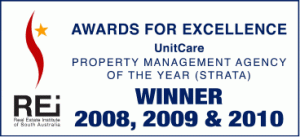Boundaries – Community Titles: Who owns what?
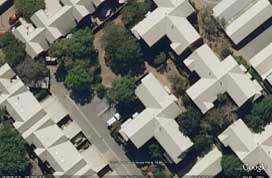
In this chapter, we explain what is common property and what is the owner’s responsibility in a community titled group.
As discussed in our introduction there are two types of Community Titles:
- Community Schemes
- Community Strata Schemes
Regardless of the type of community title, both divide land to create lots and common property in a similar manner to strata titles.
Each plan must divide the land to create at least two community lots and common property.
Primary Community Scheme: The satellite image and plan below are of a primary community plan. Each building sits on its own lot. The owners have title to the land under the lot and the sky above, unlike strata titles. They are responsible for the maintenance and insurance of their respective buildings. Where buildings share a common (party) wall the owners of each building are jointly responsible for its maintenance.
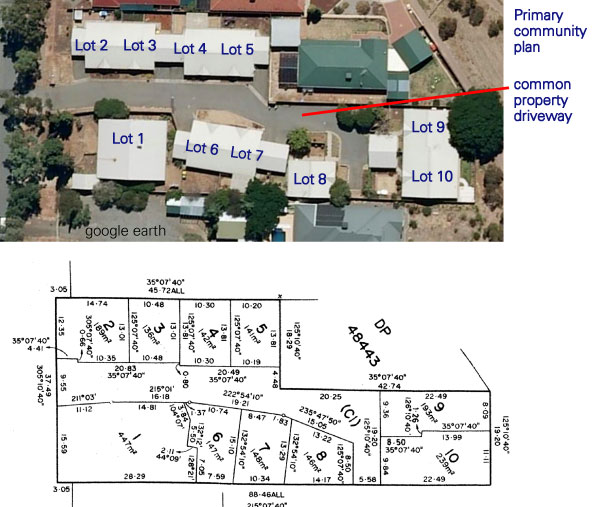
In the above picture, the common property is the shared driveway down the middle of the group. The body corporate is responsible for its maintenance under Section 28 of the CTA.
Legislation
Section 28 of the Community Titles Act goes on to explain in detail the structures and services that are the Corporation’s responsibility to maintain.
28—Common property
(1) The common property created by a community plan comprises—
(a) those parts of the community parcel that do not comprise or form part of a lot; and
(b) the service infrastructure (except for any part of the service infrastructure that is vested in a Minister of the Crown or other authority or person, and the parts of the service infrastructure that provide a service to only one lot); and
(c) in the case of a strata plan, those parts of the building that are not part of a lot.
Primary Strata Schemes: The photograph and plan below are of a primary strata community plan.
In a community strata scheme, the lot boundaries must be defined by reference to parts of the building, this is similar to a strata title. There must be at least one lot that exists above another unless the scheme was previously a strata scheme under the Strata Titles Act, and has converted by resolution, to adopt the Community Titles Act.
The structure itself is common property and it is, therefore, the responsibility of the corporation to maintain and insure it. In this regard, community strata schemes are very similar to strata-titled unit groups. The group below has one unit above another and consequently is a community strata scheme.
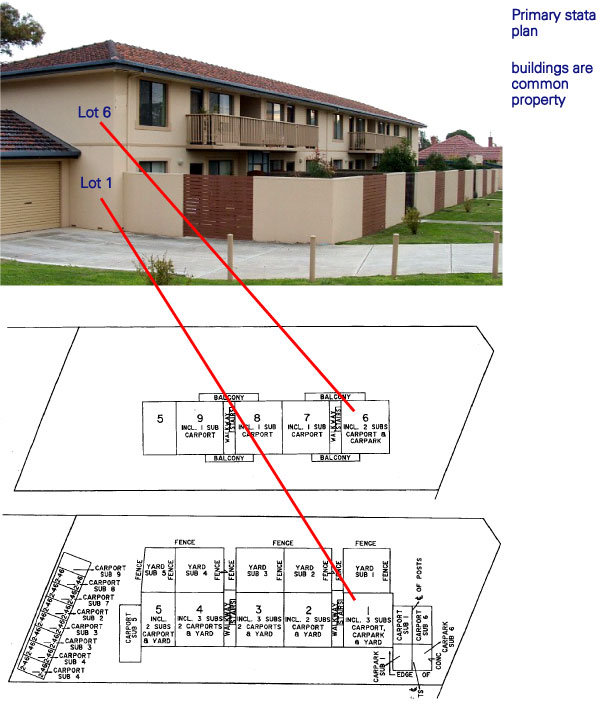
The internal walls and lot subsidiaries are not common property but are the owner’s to maintain.
The Corporation is responsible for maintaining the common property. Common property includes land that is not within a lot, and infrastructure (driveways, water, sewer, electricity etc.) that do not serve single lots, are common property and the Corporation’s to maintain.
In the case of a strata scheme, this includes the external walls and floors, the foundations, the roof, the space in the roof, gutters and eaves immediately below the gutters. This does not include the owner’s fixtures and fittings such as kitchens and bathrooms.
Section 19 of the Community Titles Act explains the nature of Community Strata Schemes.
Legislation
Section 19: Special provisions relating to strata plans
(1) A strata plan must divide the building on the community parcel (or, if there is more than one building, at least one of them) so as to create at least one lot that is situated above another lot in the building.
(2) Subsection (1) does not apply to a strata plan that was originally deposited in the Lands Titles Registration Office under the Strata Titles Act 1988 and has become a strata plan under this Act by virtue of an election under clause 2 of the Schedule.
(3) A strata lot—
(a) may be below, on or above the surface of land; and
(b) may be wholly on one storey or partly on one storey and partly on another or others; and
(c) must have upper and lower boundaries as well as lateral boundaries that are defined by reference to parts of the building; and
(d) may include an area (a lot subsidiary) within the building or comprising land outside the building to be used for a purpose that is ancillary to the purpose
for which the rest of the lot is to be used.(4) Subject to any explicit statement to the contrary in a strata plan, the following principles apply to the definition of a lot by strata plan—
(a) where a boundary is defined by reference to a wall or fence—the boundary is the inner surface of the wall or fence;
(b) where a boundary is defined by reference to a floor—the boundary is the upper surface of the floor;
(c) where a boundary is defined by reference to a ceiling or roof—the boundary is the under surface of the ceiling or roof.
See Boundaries under Strata Titles for a diagram
Hint
| Check the top right hand side of the plan. It will state if it is a Primary, Secondary or Tertiary Strata. Note the CP above the plan type. This designates it as a Community Plan. |
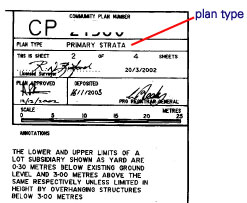 |
Best Practice
Make sure your group has an up-to-date set of Community Plans. Circulate a copy of the plans to all existing owners and new owners as they join your Corporation.
Check the plan for any notation on the boundaries.
The Lands Services Office can supply a copy of your group’s plans if needed or you can contact our office and for $25 we can supply a full set of plans for your group
Hint
The Lands Services Office can supply a copy of your group’s plans if needed.

